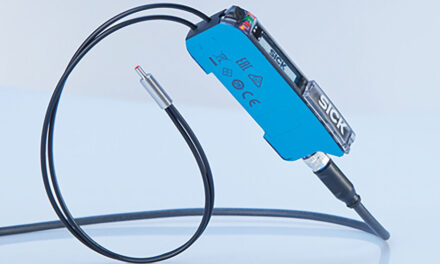 Joshua Edberg and Fred Hintz at Honeywell Sensing & Control discuss using high sensitivity hall effect sensors to control brushless DC motor applications
Joshua Edberg and Fred Hintz at Honeywell Sensing & Control discuss using high sensitivity hall effect sensors to control brushless DC motor applications
Historically, sensor manufacturers have been able to achieve high sensitivity in bipolar latching Hall effect sensors for Brushless DC (BLDC) motor applications by using chopper stabilisation, a technique used to control sensitivity and stability over temperature ranges for a Hall element. As a result, chopper stabilisation has become synonymous with high sensitivity and stability in Hall effect sensors.
With today’s new technologies and processes, magnetic sensor manufacturers can successfully achieve high sensitivity and magnetic stability without using chopper stabilisation.
BLDC motors can be used in any application that needs an efficient and quiet motor, ranging from robotics and portable medical equipment to large HVAC fans and appliances. BLDC motors are highly efficient, delivering more energy per unit compared to brush-type DC motors.
These motors are growing in popularity due to the world’s need for greater energy efficiency. BLDC motors use electronic commutation versus mechanical commutation in brush-type DC motors to control power distribution to the motor. Latching Hall effect sensors measure the motor’s position, which is communicated to the electronic controller to apply energy to the motor at the right time and right orientation.
BLDC motor manufacturers have moved toward using chopper-stabilised latching sensors for electronic commutation, but what is actually required is a high-sensitivity part that is stable over its specified temperature range.
The following discussion dispells three myths that have led designers to request chopper-stabilised bipolar latching Hall effect sensors instead of choosing several other options that can more efficiently commutate the motor.
Myth 1: Chopper stabilisation is ideal for latching sensors in BLDC motors
Although chopper stabilisation can offer high sensitivity and more magnetic stability, it has several drawbacks including slower response time, accuracy error (due to sampling), and electrical noise generation.
Hall effect sensors are operated by a magnetic field from a permanent magnet or an electromagnet responding to North and South Poles. These magnetic sensors measure the change in magnetic field and communicate the position of the motor shaft to a logic unit, which uses this information to determine when the current should be applied to the motor coils to make the magnets rotate at the correct orientation.
Chopper stabilisation, which is continually averaging the induced voltage across the Hall elements to determine the output signal, slows down how fast a sensor switches. As a result, a chopper-stabilised part typically switches at a delayed magnetic field level due to the slower response.
The path to higher accuracy
By eliminating the need for chopper stabilisation, the latching sensor has a faster response time. This means the motor is commuted at or closer to the correct time, translating into higher accuracy, which ultimately leads to a more efficient motor. Another benefit of a non-chopper-stabilised sensor is that it does not generate additional electric noise, thus eliminating the need for extra filtering.
Myth 2: Chopper stabilisation is the only way to achieve stability over the operating temperature range for a Hall effect sensor
Many designers believe the misconception that non-chopper-stabilised parts are not stable. In reality, one of the most important factors contributing to the sensor’s stability starts with the Hall element used by the manufacturer.
Many sensors today utilise single and dual Hall effect elements, which are susceptible to wide ranges of magnetic performance due to packaging stresses. To mitigate these stresses, most manufacturers use an averaging process (chopper stabilisation) to provide a more stable operation over voltage and temperature.
Another way to realise stability is to start with a more stable Hall effect element. A quad Hall element is less susceptible to stress-induced error because voltage is measured in four directions, cancelling the offsets in each element to provide stable operation over the operating temperature range. A quad Hall element offers more stable sensor performance, requiring less averaging correction than what chopper stabilisation provides.
In addition, Hall sensors utilising this technology are not larger than their single or dual Hall element counterparts using chopper stabilisation.
Myth 3: Chopper stabilisation is required to achieve high sensitivity in latching Hall effect sensors for BLDC motor commutation
Chopper stabilisation is not the only way to achieve high sensitivity. Other technologies and processes are available to manufacturers for high-sensitivity magnetic sensing.
As an alternative to chopper stabilisation, Honeywell Sensing and Control has developed a high-sensitivity bipolar latching sensor by combining a quad Hall element and proprietary programming without chopper stabilisation.
This programming adjusts the magnetics to account for the effects of packaging stresses, thus contributing to the sensor’s high sensitivity. This design is said to offer the required high sensitivity and stable magnetics for BLDC motors, along with the additional benefits of faster response time, repeatability, improved jitter performance (which is critical for BLDC efficiency), and no additional electric noise generation.
Technology has come a long way to make a highly sensitive latching Hall effect sensor that is stable over the wide temperature range needed for BLDC motors. When deciding on the right technology, design engineers need to understand both the positives as well as the drawbacks of chopper stabilisation and take these into consideration to design the most efficient motor for their customers.
Joshua Edberg is Senior Global Marketing Manager & Fred Hintz is Engineering Manager both at Honeywell Sensing and Control
Honeywell Sensing and Control



